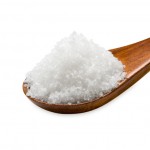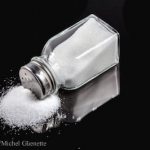A new study conducted at the University of Bonn in Berlin has fond that eating too much salt weakens the immune system, which may make people more susceptible to foodborne illness. Of course, it makes you more vulnerable to all other bacterial infections as well. And a high sodium diet causes hypertension, a risk factor for heart attacks and strokes. In the study, mice who where fed a high salt diet suffered from "much more severe" bacterial infections. Human volunteers were then fed an additional six grams of salt per day. They also showed "pronounced immune deficiencies." The amount of extra salt they were given is the salt content of two fast food meals. The study says that people should eat five grams of salt a day, no more. That is the maximum daily amount recommended by … [Read more...]
How Much Salt Do You Really Eat?
The FDA is warning consumers that they may be consuming far more salt than they think. Even if you don't salt your food at the table or while cooking, you are probably consuming a lot of sodium, especially if you eat prepared or processed foods. Most of the sodium in the American diet comes from supermarket foods and restaurant meals. So the FDA is working to gradually reduce the amount of sodium that processors add to food. Draft guidance for industry has been released that sets voluntary goals for reducing sodium levels in processed and prepared foods. Note that their guidance is voluntary, which means that processors and restaurants do not have to abide by the levels. The maximum sodium intake per day for adults should be about 2,300 milligrams, which is the amount in a … [Read more...]
FDA Wants to Reduce Sodium in the Food Supply
The FDA is planning to reduce sodium in the food supply. The link between sodium consumption and blood pressure is well documented. Most people need to reduce their sodium consumption to less than 2,300 mg per day. And most of that consumption, about 75%, comes from processed and prepared foods, not the salt shaker. Some companies have reduced sodium in their products, but many foods still contain a lot of salt. On average, Americans consume 3,400 mg of sodium every day, more than 50% above the recommended limit. Children also eat more than is recommended. Most children consume from 2,900 mg a day, and teenagers consume 3,700 mg per day. High blood pressure is a major risk factor for heart disease and stroke. A lower sodium intake is associated with a lower risk of cardiovascular … [Read more...]
CDC Vital Signs: Children Consume Too Much Sodium
The Centers for Disease Control and Prevention (CDC) has released a new Vital Signs monthly report that focuses on sodium in children's diets. The report states that a bout 9 in 10 U.S. children eat more sodium than recommended. Most is consumed as salt in processed foods. Children ages 6 to 18 years in this country eat an average of 3,300 mg of sodium every day before salt is added at the table. The recommended amount is less than 2,300 mg a day. A high sodium diet can lead to high blood pressure; in fact, about 1 in 6 children in this country has high blood pressure. Lowering sodium in your child's diet today can help prevent heart disease in the future. The taste for salt is established at a young age. Children eat about 15% of the daily sodium amount at breakfast, 30% at lunch, … [Read more...]
CSPI Estimates 400,000 Preventable Deaths from Salt Since 2010
Four years ago, the Institute of Medicine asked the FDA to set limits on sodium levels allowed in processed food. The FDA has still not acted on those recommendations. Excess sodium is linked to stroke, heart attack, and other health problems. The Center for Science in the Public Interest (CSPI) states that "if Americans had cut their sodium intake in half beginning in April 2010, as many as 400,000 lives might have been saved." CSPI health promotion policy director Jim O'Hara said, "FDA would probably act in a heartbeat if experts found that an unsafe drug or medical device was responsible for 100,000 deaths a year, but it is tolerating a deadly level of sodium in our food supply. While this Administration talks about the need for healthy eating, it is failing to pursue a policy that … [Read more...]
CDC Wants Restaurants to Reduce Sodium Content
The Centers for Disease Control and Prevention (CDC) wants restaurants to lower the sodium content of the foods they offer. The agency just issued a report called "From Menu to Mouth: Opportunities for Sodium Reduction in Restaurants", which was published in CDC's journal, Preventing Chronic Disease. Americans eat out, either at fast food or dine-in restaurants, four or five times a week. And just one of those meals can contain more than an entire day's recommended amount of sodium for an adult, which is about 2,300 milligrams. On average, fast food meals have 1,848 mg of sodium per 1,000 calories. Foods served in dine-in restaurants have 2,090 mg of sodium per 1,000 calories. Foods obtained in restaurants contributed to 24.8% of the sodium consumed in this country during 2007 to … [Read more...]
MMWR: Trends in Prevalence of Excess Dietary Sodium
The Morbidity and Mortality Weekly Report has a paper on trends in the prevalence of excess dietary sodium intake in the U.S. from 2003 to 2010. Excess sodium intake is a problem in this country. Eating too much sodium can lead to hypertension, the primary risk factor for cardiovascular disease. Reducing population sodium intake is a national priority. CDC analyzed data from the national Health and Nutrition Examination Survey (NHANES) of 34,916 participants. Tolerable upper intake levels are 2,300 mg per day for anyone over the age of 14. They found that the majority of the U.S. population over the age of 1 year consumes too much sodium. The prevalence of excess usual sodium intake ranged from 79.1% for children aged 1-3 years to 95.4% for U.S. adults aged 19-50 years. A small … [Read more...]
FDA Helps Consumers Reduce Sodium Intake
The Food and Drug Administration wants to help American consumers reduce their sodium intake. On average, U.S. consumers eat about 3300 mg of sodium every day, a full 1000 mg above the 2010 Dietary Guidelines level of 2300 mg. That much sodium can cause development and escalation of high blood pressure, which is a leading cause of stroke, heart disease, and kidney disease. Anyone over the age of 51 should reduce their sodium level to just 1500 mg daily. The CDC has reported that children and adolescents consume this high level of sodium too, which doubles their risk of developing high blood pressure. Dr. Jessica Leighton, senior advisor for science in the FDA's Office of Food and Veterinary Medicine, said, "There has been a common misconception that sodium intake is just a concern for … [Read more...]
Chronic High Sodium Diet Associated with Hypertension
New research published in the America Heart Association's journal Circulation has found that in people who do not have high blood pressure (hypertension), a chronic high sodium diet is associated with the development of that disease. Researchers thought that a high sodium diet, over time, would cause damage to blood vessels in the endothelial layer. The study followed the sodium intake of 5,556 men and women in a city in the Netherlands as part of the PREVEND (Prevention of REnal and Vascular ENd stage Disease) study. They found that a diet sodium diet was associated with increases in two biomarkers that indicate endothelial dysfunction: serum uric acid (SUA) and urine albumin excretion (UAE). The endothelium in blood vessels is the thin layer of cells that line the interior surface. … [Read more...]
American Heart Association Proposes Change to Salt’s GRAS Status
The American Heart Association has commented on the FDA's proposal to reduce American consumer's sodium consumption with an interesting twist. That organization would like to see salt's status as a "safe ingredient" modified. The AHA would also like to see more limits put on the process that lets food companies make their own GRAS determinations. The GRAS List GRAS stands for Generally Regarded As Safe. That list of food additives was developed in 1958 as an amendment to the 1938 Federal Food, Drug, and Cosmetics Act. It distinguishes between new additives that need FDA approval before use, and additives and ingredients that have been used for years and are deemed safe "with a consensus of expert opinion" and "reasonable scientific certainty that the substance is harmless when used … [Read more...]







